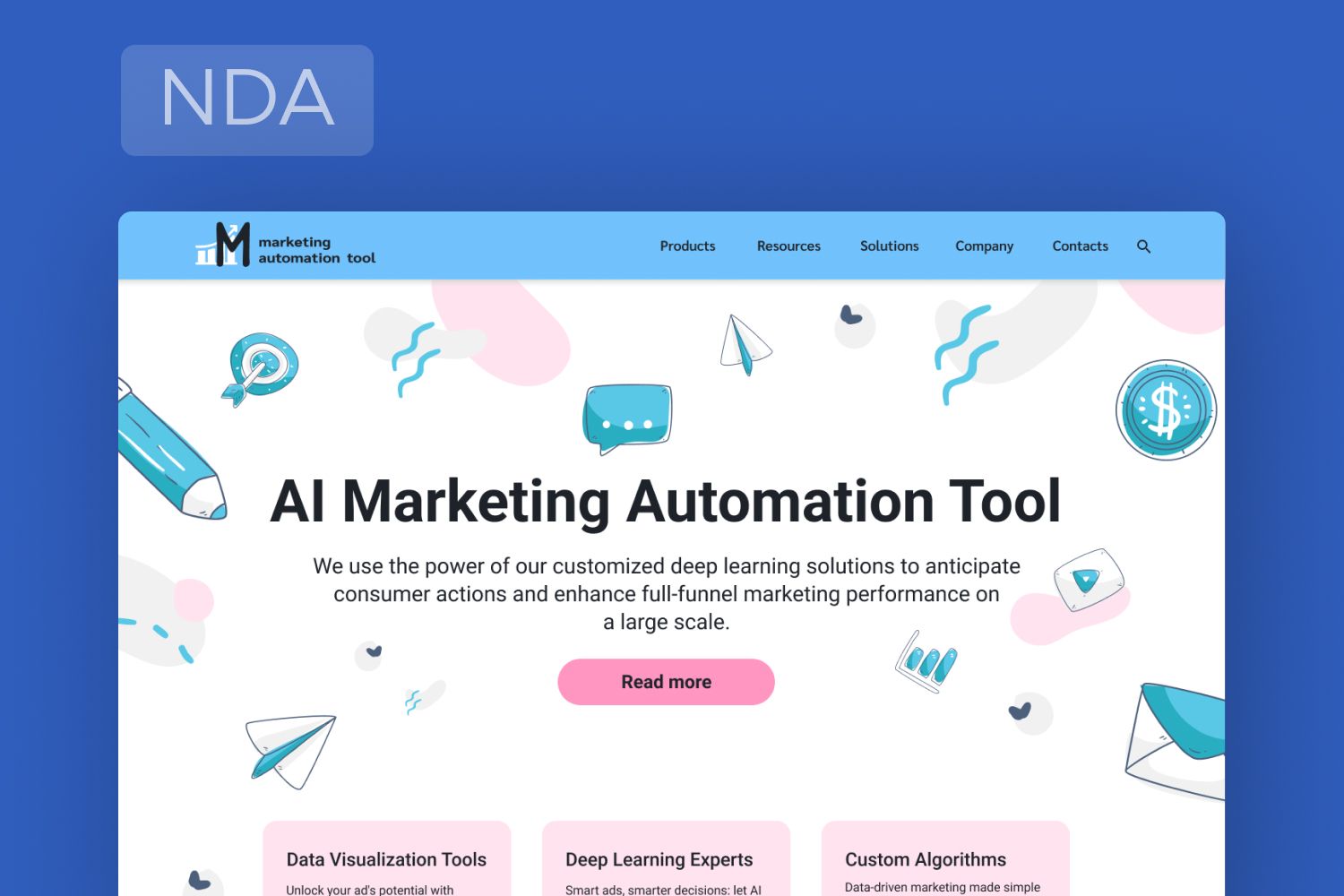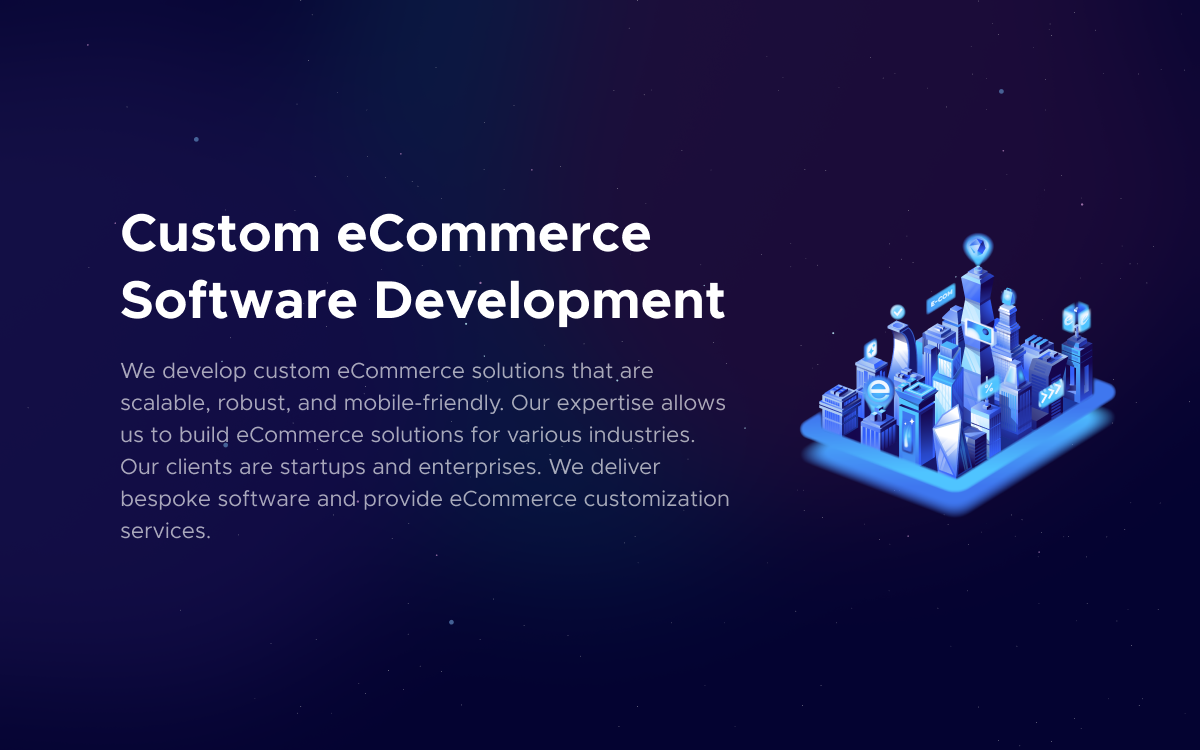Let’s Fly Inside #6: What Is Modern eCommerce Development With Andrew Niadvetski
In our fresh interview with a full-stack software specialist Andrew Niadvetski, we talk about modern eCommerce development practices, upcoming trends, and the future of eCommerce.
In the dynamic world of eCommerce, AI-enabled tools and consumer demands evolve at lightning speed, so standing out requires not just skill, but a passion for innovation and a deep understanding of the digital landscape.
That’s why today we invite you to enter this realm with a maestro of eCommerce development at Fively Andrew Niadvetski. Being a highly motivated software creator, he's an architect of game-changing eCommerce solutions and a relentless seeker of the newest trends in this domain. His deep expertise in JavaScript, TypeScript, React, and other modern front-end and back-end frameworks and APIs crafts the backbone of our user-centric and cutting-edge online shopping solutions.
But how does he manage to do all these things? In our exclusive interview, we delve into his journey, exploring the challenges and triumphs of eCommerce development, and his vision for the future of online retail. Join us as we unravel the insights from Fively's technological front-runner, shaping the eCommerce world one line of code at a time.
Hi, Andrew, and thank you for finding time for this interview! In the realm when AI is changing the way we live, work, and shop so fast, it’s brilliant to talk with a tech and eCommerce enthusiast like you!
Hi, Alesya! Sure, it’s a pleasure to talk!
First, can you please share how you found yourself in the eCommerce domain? Was it a long way or a straightforward path?
My journey into the eCommerce domain was a blend of gradual development and seizing opportunities. Starting as a developer skilled in JavaScript, TypeScript, React, Next.js, and Material-UI, I was naturally drawn to the challenges and opportunities in eCommerce. The path wasn't always straightforward, but my technical skills and enthusiasm for emerging technologies made it a rewarding venture.
I found myself increasingly involved in projects that required complex integrations with platforms like eBay, Shopify, and WooCommerce, leveraging various APIs. This experience deepened my understanding of the eCommerce ecosystem, leading to a more focused and dedicated career path in this field.
The path wasn't always straightforward, but my technical skills and enthusiasm for emerging technologies made it a rewarding venture.
Wow, that’s impressive! Is your current project also connected with eCommerce?
Indeed, my current project is closely related to eCommerce. A significant part of it focuses on integrating various 3rd-party platforms into the client’s CRM, which enables the integration of huge product catalogs between systems in just minutes. My role includes developing solutions to optimize the database performance, ensure a reliable, user-friendly interface, and implement AI in it.
By the way, React-based development is among Fively's priorities. Considering your proficiency in React and Next.js, how do these technologies benefit eCommerce apps?
React-based development, being a core focus at Fively, is particularly advantageous for eCommerce applications, given my expertise in React and Next.js. React's modular architecture enables the creation of reusable, efficient UI components, essential for maintaining consistency across various parts of an eCommerce site.
This approach enhances the user experience significantly. Moreover, Next.js brings in server-side rendering, which is crucial for eCommerce platforms. It improves load times and performance, vital for customer retention and SEO.
Plus, as our CEO Alexey Kalachik already mentioned in one of its interviews, it’s a perfect technical choice for startups and young eCommerce companies, who need to create an MVP or a prototype product quickly.
Thank you! Can you give us a project example where you significantly improved efficiency or solved a complex problem through API integration?
Yes, at our own eCommerce product - the top-notch solution for product management Otomate PIM. There, we implemented a complex integration with Shopify, eBay, WooCommerce, Facebook, and Instagram. But that’s not all, we had several objectives:
- Create catalogs on the fly, manage, edit, and review your products efficiently;
- Seamlessly store, organize, and manage your product and brand media assets;
- Connect your catalogs to popular eCommerce channels such as Shopify, WooCommerce, Facebook, and eBay in just a few clicks;
- Get insights on product data completeness and refine the content to perfection.
And we did it all successfully, which helped to reduce the time needed for catalog updates and eliminated manual data entry errors. This integration not only simplified the product management process but also enhanced the accuracy and reliability of product information across all platforms, which allowed to turn this app into one of the most popular solutions of such a kind.
By the way, Fively has its own Material-UI tool kit. Have you managed to use it in your projects?
Yes, I have extensively utilized Fively's Material-UI toolkit in my projects. Its comprehensive suite of UI components is perfectly aligned with React development, making it an invaluable resource for creating intuitive and visually appealing interfaces.
In particular, the toolkit has been instrumental in designing responsive eCommerce platforms. Its predefined yet customizable components have enabled rapid development while maintaining a consistent look and feel across the application. This has not only accelerated the development process but also ensured a cohesive user experience, which is crucial in the competitive realm of eCommerce.
What do you think is better: to create an app from the ground up, or to use the platforms like eBay, Shopify, or WooCommerce?
Whether to build an app from the ground up or to use ready-made platforms, depends on the specific goals and requirements of the project. For small businesses seeking a quick launch with minimal hassle, a Shopify-based solution stands out for its user-friendly interface and extensive range of built-in features.
WooCommerce, with its integration into WordPress, offers more customization and flexibility, is suited for businesses with specific needs that require more tailored solutions. eBay is a different model, focusing more on marketplace capabilities, which is excellent for businesses looking to tap into an existing vast customer base.
When we speak about building solutions from scratch, it offers unparalleled customization and 100% control, which is ideal for unique and game-changing eCommerce solutions. This approach allows for tailoring every aspect of the application to specific business needs, but it requires more resources and time.
Thus, ready-made platforms provide you with less flexibility and customization, but a shorter development cycle, so they can be a good choice for businesses looking to launch quickly.
But, I would like to empathize that none of these platforms can be compared to a custom solution built from scratch according to your business needs: it will ideally fit in your workflow, and you won’t pay for the functional you don’t use, as it often occurs with ready-made solutions.
Building eCommerce apps from scratch offers unparalleled customization and control, which is ideal for unique and game-changing market solutions.
Do you share the current trend for device-first eCommerce development? And what are some best practices in eCommerce development?
In today's digital landscape, I align with the device-first approach for eCommerce development, especially considering the increasing prevalence of mobile shopping. This approach ensures that eCommerce platforms are optimized for mobile devices from the outset, providing a seamless shopping experience across all devices.
However, this doesn't diminish the importance of robust web architecture. A balanced strategy that caters to both mobile and web users is often the most effective.
In general, best practices in eCommerce development from my experience include:
- Responsive Design: Ensuring that the eCommerce site is visually appealing and functional on all devices, whether it's a desktop, tablet, or smartphone.
- Performance Optimization: Prioritizing fast loading times and smooth site performance, as slow websites can lead to higher bounce rates.
- User-Friendly Navigation: Creating an intuitive and easy-to-navigate interface, which is crucial for enhancing user experience and encouraging purchases.
- Security Measures: Implementing robust security protocols to protect customer data and transactions, which is vital for building trust and credibility.
- SEO Best Practices: Employing SEO strategies to improve visibility and ranking on search engines, which is essential for driving organic traffic.
- Data Analytics: Utilizing data analytics tools to understand customer behavior and preferences, thereby enabling more targeted and effective marketing strategies.
- Continuous Testing and Iteration: Regularly testing various aspects of the eCommerce site, such as user interface, checkout process, and performance, to continually refine and improve the user experience.
Speaking about mСommerce, what percent of online retailers now have mСommerce websites?
If I’m not mistaken, according to Statista, smartphones accounted for over 70% of all retail websites in 2023. This shift is driven by the growing use of smartphones and mobile devices for online shopping, as well as changing consumer behaviors favoring convenience and on-the-go accessibility. I’m sure, this number will only increase, as more businesses continue to recognize the importance of catering to mobile users to stay competitive in the digital marketplace.
“The number of mCommerce websites will only increase, as businesses now recognize the importance of catering to mobile users to stay competitive in the digital marketplace.”
AI has become a buzzword nowadays. Have you personally managed to implement some AI-based features into your eCommerce apps?
Yes, AI has indeed become a pivotal aspect of modern technology, and I have had the opportunity to integrate AI-based features into eCommerce applications. For instance, I've implemented AI-driven recommendation engines that personalize user experiences by suggesting products based on browsing history and purchase behavior. This not only enhances the user experience but also increases the likelihood of sales.
Additionally, I've utilized AI for customer service automation through chatbots. These AI-powered chatbots can handle basic customer inquiries and complaints, providing instant responses and improving overall customer satisfaction.

ECommerce web apps can be really huge and complex, like Amazon or eBay. How do you approach database performance optimization for high-traffic eCommerce websites?
As I often work with various high-traffic eCommerce platforms, I've honed my own strategy for optimizing database performance. It starts with a solid foundation: a well-structured database, where I prioritize normalizing the database to cut out redundancy and apply indexing smartly, which is essential for handling large data volumes.
Caching is a real game-changer here. Implementing query and object caching significantly cuts down database load, especially for static data. It's like fast-tracking the most frequently accessed data.
Also, I always use database sharding, as it involves splitting the database into smaller parts to distribute the load and speed up read/write operations, and load balancing, where queries are distributed across multiple servers, to ensure smooth performance during high traffic periods.
Plus, using a Content Delivery Network (CDN), though not directly a database optimization technique, can significantly lighten the server's load and improve response times. I can also spend a considerable amount of time refining SQL queries for peak performance. In some cases though, I prefer using NoSQL databases, as they’re more efficient than traditional relational databases, particularly for unstructured data or when prioritizing read/write speed.
Continuous monitoring and analysis of the database's performance are crucial. Regularly updating statistics, rebuilding indexes, and cleaning up unnecessary data keeps the database in top condition. This approach helps identify bottlenecks and understand usage patterns, guiding informed optimization decisions.
My strategy for database performance optimization: a well-structured architecture, catching, databases sharding, using a CDN, refining the SQL queries, and continuous monitoring.
When collaborating with cross-functional teams on a project, how did you ensure clear communication and project success, especially when technical complexities arose?
In cross-functional teams, I always prioritize regular and clear communication so that we all can be on the same page. I discuss all the issues as soon as they arice, and maintain updated documentation to keep everyone informed about project changes and progress. I think good communication is the most important part of such projects.
Let’s talk a bit about trends: "Quick commerce" is becoming a pivotal aspect of eCommerce. How would you optimize your eCommerce platform to fit such a need if necessary?
Yes, quick commerce is a hot topic right now. To support the quick commerce trend, especially for same-day delivery in an eCommerce platform, back-end operations need to be highly optimized: this includes streamlining the order processing system to minimize delays, using AI and machine learning for predictive analytics to manage inventory effectively, and integrating real-time logistics tracking.
Also, I would pay attention to automating key processes, such as order fulfillment and dispatch, with robust software solutions, and Collaborate closely with logistics partners to ensure seamless delivery and flawless customer service.
There is a growing trend for the use of passwordless eCommerce platforms, such as face ID-based apps, for example. What is your choice?
Actually, both approaches have their pros and cons. Passwords are a resilient method, but they can be intricate to manage if many, while biometric ID offer convenience, yet in the event of data leakage, they can't be effortlessly altered.
Nowadays, new auth methods are being investigated, including the recognition of user behavioral patterns, blockchain integration, etc. Passwordless authentication methods like face ID are becoming popular in eCommerce due to their enhanced security and user convenience. They reduce password-related breaches and streamline the login process.
However, I believe that it’s crucial to balance security with privacy, ensuring biometric data is protected and complies with privacy regulations. Conceivably, the future might unveil a more well-rounded approach, amalgamating diverse methods to ensure the utmost in security and user-friendliness.
I believe that it’s crucial to balance security with privacy, ensuring biometric data is protected and complies with privacy regulations.
In general, which is one of the main sectors of eСommerce nowadays?
To my mind, one of the main sectors in eCommerce nowadays is the Online Retail or B2C sector, including apparel, electronics, home goods, groceries, and personal care items. This sector has experienced significant growth, especially following the digital shift accelerated by the COVID-19 pandemic.
Companies in this sector are increasingly focusing on enhancing user experience, mobile commerce, personalized marketing, and seamless payment and delivery options to meet the evolving demands of consumers. The integration of advanced technologies like AI, AR/VR, and big data analytics for personalized shopping experiences has further elevated the significance of the online retail sector in eCommerce.
Considering the rise of shoppable videos and voice-enabled e-shopping, how would you integrate these features into an existing eCommerce platform using your current tech stack?
To implement shoppable videos and voice-enabled e-shopping, I'd build a cutting-edge AI-driven recommendation system. This system would use advanced NLP and computer vision to analyze user interactions with videos and voice commands, providing personalized product recommendations in real-time.
"Dark social" refers to private, encrypted sharing that's difficult to track traditionally. How can eCommerce platforms leverage this channel while maintaining user privacy?
The main thing here is security. ECommerce platforms can leverage "dark social" by offering secure and private communication channels within their apps, for example, end-to-end encrypted messaging features that allow users to share products and recommendations privately.
To maintain user privacy, platforms should prioritize robust encryption and user consent for data sharing. Additionally, implementing features like anonymous user IDs can help track referrals and conversions without compromising user identity.
What is your attitude towards digital twins used in eCommerce ads? What are your ethical considerations towards participating in such a project?
I believe it's essential to approach this technology with transparency and ethical considerations. Digital twins can enhance the shopping experience by providing more detailed product information and allowing customers to visualize products better. However, it's crucial to ensure that these representations are accurate and not misleading.
From an ethical standpoint, I believe in obtaining user consent for data collection and personalization, especially when it comes to creating personalized digital twins. Respecting user privacy and data security should always be a priority. Additionally, retailers should be transparent about the use of digital twins in their ads and provide clear explanations of how they benefit the customer.
To take it short, I support the use of digital twins in eCommerce ads as long as it is done ethically, transparently, and with the customer's best interests in mind.
I support the use of digital twins in eCommerce ads as long as it is done ethically, transparently, and with the customer's best interests in mind.
You’re a tech-savvy and highly motivated specialist. What are your secrets to staying energetic? Is it hard to motivate yourself and your team?
Well, probably, I’ll sound a bit banal, but maintaining a work-life balance is really essential for me to stay energetic and motivated. I always try to take regular breaks, engage in hobbies or activities outside of work, and ensure adequate rest.
Thrills, speed, and the great outdoors – that's what fuels my passion for motorcycling. There's nothing quite like the rush of riding my bike through dense forests, the wind in my face, and the world zooming by. It's the sense of freedom and the pure adrenaline that comes with enduro riding.
Apart from my love for motorcycles, I'm deeply committed to staying active and healthy. Running is another pursuit that I find incredibly rewarding. Plus, it's a way to challenge myself, to set goals and smash them.
These hobbies help me prevent burnout and keep my mind fresh and productive. Every time I hit the trail or lace up my running shoes, it's a new opportunity to explore, grow, and feel alive.
Every time I hit the trail or lace up my running shoes, it's a new opportunity to explore, grow, and feel alive.
As an eCommerce development specialist and technology enthusiast, how do you see the future of eCommerce?
Well, yes, I have a few thoughts on where the future of eCommerce is headed. First of all, personalization is becoming increasingly sophisticated, driven by AI and machine learning. Soon, every aspect of online shopping, from product recommendations to customized content and marketing, will be tailored to each customer's unique preferences. This shift will significantly enhance the shopping experience.
The boundary between online and offline shopping is also fading. Today's retailers should create fluid, omnichannel experiences that connect mobile apps, websites, social media, and brick-and-mortar stores. It's already become a must nowadays to offer a seamless journey, regardless of where the customer chooses to engage.
Plus, technologies like AR and VR are set to transform how we view products online. Imagine virtually trying on clothes or visualizing how a new sofa looks in your living room before making a purchase - these technologies are bringing the in-store experience into the digital realm.
Voice commerce is another area poised for growth. With voice assistants like Alexa and Google Assistant, shopping becomes as simple as speaking. It's a game-changer for convenience, allowing for easy order placement and personalized product recommendations.
The demand for quick and contactless delivery is skyrocketing. Consumers want their purchases delivered not just rapidly but also in an environmentally friendly way. And let's not forget about sustainability: consumers are increasingly conscious of the environmental impact of their purchases and are gravitating towards brands that prioritize eco-friendly and ethical practices.
The future of eCommerce is exciting and dynamic, shaped by tech innovations and changing consumer preferences, and I'm eager to see how these trends will unfold.
At the end of the interview, can you share with us your next career goals? And what advice you’d like to give to junior eCommerce endeavors?
Certainly, my next career goals include further specializing in eCommerce and technology, potentially taking on leadership roles in larger projects, and continuing to contribute to the field's growth through innovation.
As for advice to junior eCommerce enthusiasts, I would like to give several pieces of advice grounded on my own experience:
- Continuous Learning: Stay curious and never stop learning. The eCommerce landscape evolves rapidly, so keeping your skills and knowledge up-to-date is crucial;
- Hands-On Experience: Don't just learn theory; apply it in practical projects. Building and launching your own eCommerce project, even a small one, can provide invaluable experience;
- Networking: Build a strong professional network. Attend industry events, engage with experienced professionals, and learn from their insights and experiences;
- Problem Solving: Develop problem-solving skills. eCommerce often involves complex challenges, and the ability to find creative solutions is a valuable asset;
- Adaptability: Be adaptable and open to change. The eCommerce industry is dynamic, and the ability to pivot when needed is essential;
- User-Centric Approach: Always keep the end-user in mind. User experience is paramount in eCommerce, so prioritize user-friendly solutions;
- Ethical Considerations: Be mindful of ethical considerations in eCommerce, including data privacy and sustainability. These factors are increasingly important to customers;
- Mentorship: Seek mentorship from experienced professionals. Learning from their mistakes and successes can accelerate your growth.
Finally, be passionate about what you do, as eCommerce is a vibrant and exciting field, and your enthusiasm will drive your success. Remember that every step you take in your eCommerce journey, no matter how small, contributes to your growth and expertise. Stay committed, and you'll find fulfilling opportunities in this ever-evolving industry.
Be passionate about what you do, as eCommerce is a vibrant and exciting field, and your enthusiasm will drive your success.
This is the very end of our exciting interview with an eCommerce specialist Andrew Niadvetski. How did you find it? What was the most thrilling part? Which eCommerce trends do you anticipate most?
While our conversation here concludes, the adventure at Fively in the realms of eCommerce is just taking flight, so don’t hesitate to contact us and ask any related questions! We'd love to hear your takeaways from this interview, so don't hesitate to share your thoughts across our social networks. And remember, our eCommerce specialists are always on standby, eager to bring your dream application to life. Let's fly!

Need Help With A Project?
Drop us a line, let’s arrange a discussion















